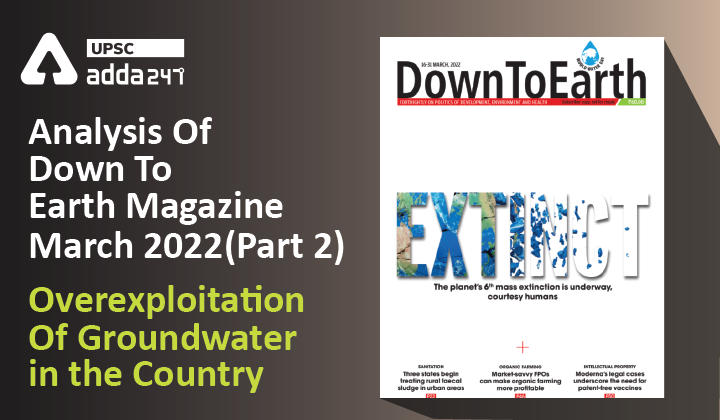Table of Contents
Analysis Of Down To Earth Magazine: ”Overexploitation Of Groundwater in the Country”
Relevance
GS 3: Conservation, Water Resources, Irrigation
Introduction
- Three of the world’s top five groundwater-extracting countries are in Asia, with India leading the list.
- At least 10 states in the country have districts that overexploit groundwater.
- As per the Jal Shakti ministry’s assessment, the annual groundwater extraction in the country for all uses is 249 billion cubic metres, out of which 89 per cent is utilised for irrigation and the remaining 11 per cent for industrial and domestic use.
Countries with the highest groundwater abstraction
India – 251 km³/year
China – 112 km³/year
US – 111.7 km³/year
Pakistan – 64.8 km³/year
Countrywide Situation
- The over-exploitation of groundwater resources is the highest in Punjab among all other states in the country.
- Punjab is followed by Delhi with 65 per cent and Rajasthan with 63 per cent. In Haryana, 61 per cent of the assessment units were being over-exploited.
- While over-exploitation of groundwater is the highest in some regions, there are many states and union territories where there is no over-exploitation.

- The Central Groundwater Board of India estimates that about 17% of groundwater blocks are overexploited (meaning the rate at which water is extracted exceeds the rate at which the aquifer is able to recharge) while 5% and 14%, respectively, are at critical and semi-critical stages.
- India is home to 16% of the world’s population, but only holds 4% of the world’s freshwater resources.
What GOI is doing?
- The government of India regulates groundwater exploitation in water-stressed states through “notification” of highly overexploited blocks that restrict the development of new groundwater structures (except those for drinking water). However, only about 14% of the overexploited blocks in the country are currently notified.
- Though there is no proposal to restrict the use of groundwater in the agriculture sector, central and state authorities are regulating groundwater use by industries and mining projects.
Jal Shakti Abhiyan (JSA)
- The government of India launched Jal Shakti Abhiyan (JSA) in 2019, a time-bound campaign with a mission mode approach intended to improve water availability including groundwater conditions in the water-stressed blocks of 256 districts in India.
- Further, Ministry launched ‘JSA-II-Catch the Rain’ on 21 December 2020 for awareness generation among people.
Atal Bhujal Yojana (Atal Jal)
- The government of India is implementing the Atal Bhujal Yojana (Atal Jal), a Central Sector Scheme, for sustainable management of groundwater resources with community participation.
- Atal Jal is being implemented in 80 water-stressed districts of seven States viz. Gujarat, Haryana, Karnataka, Madhya Pradesh, Maharashtra, Rajasthan and Uttar Pradesh.
What States are doing?
- Water being a State subject, initiatives on water management including conservation and water harvesting in the Country is primarily States’ responsibility.
- A number of States have done notable work in the field of water management/conservation.
- Of these, mention can be made of ‘Mukhya Mantri Jal Swavlamban Abhiyan’ in Rajasthan, ‘Sujalam Sufalam Abhiyan’ in Gujarat, ‘Mission Kakatiya’ in Telangana, ‘Neeru Chettu’ in Andhra Pradesh, ‘Paani Bachao, Paisa Kamao’ in Punjab and ‘Jal Hi Jeevan’ in Haryana among others.
About Central Ground Water Authority
- Central Ground Water Authority (CGWA) has been constituted under Section 3 (3) of the “Environment (Protection) Act, 1986” for the purpose of regulation and control of groundwater development and management in the Country.
- CGWA grants No Objection Certificates (NOCs) for ground water abstraction to Industries, Infrastructure units and Mining projects in feasible areas in certain States/UTs where regulation is not being done by the respective State/UTs
What should be done?
- Measures such as surface water harvesting through farm ponds and check-dams, the installation of water-efficient irrigation systems (e.g. more efficient drips and sprinklers) and growing less water-intensive crops, need to be integrated on the demand side for improved management and reduced depletion.
- Local-level regulatory action in all threatened blocks before they reach the “overexploited” stage is vital to avert depletion.

- The participatory Groundwater Management approach (PGM) should be adopted countrywide as it empowers communities in a defined aquifer area by providing governance rights, community awareness, capacity development, and knowledge and motivation for social regulation and the implementation of coordinated actions.
- The key institutional challenge for groundwater governance is strengthening local institutions and helping the informal groups to remain viable during the post-project phase.
Conclusion
Groundwater extraction has allowed rural families to reduce short-term vulnerability but may incur trade-offs and increase the risk of depletion and ultimately increase vulnerability in the long term. So, we need to move back to traditional scientific methods of storage and use.



 TSPSC Group 1 Question Paper 2024, Downl...
TSPSC Group 1 Question Paper 2024, Downl...
 TSPSC Group 1 Answer key 2024 Out, Downl...
TSPSC Group 1 Answer key 2024 Out, Downl...
 UPSC Prelims 2024 Question Paper, Downlo...
UPSC Prelims 2024 Question Paper, Downlo...




